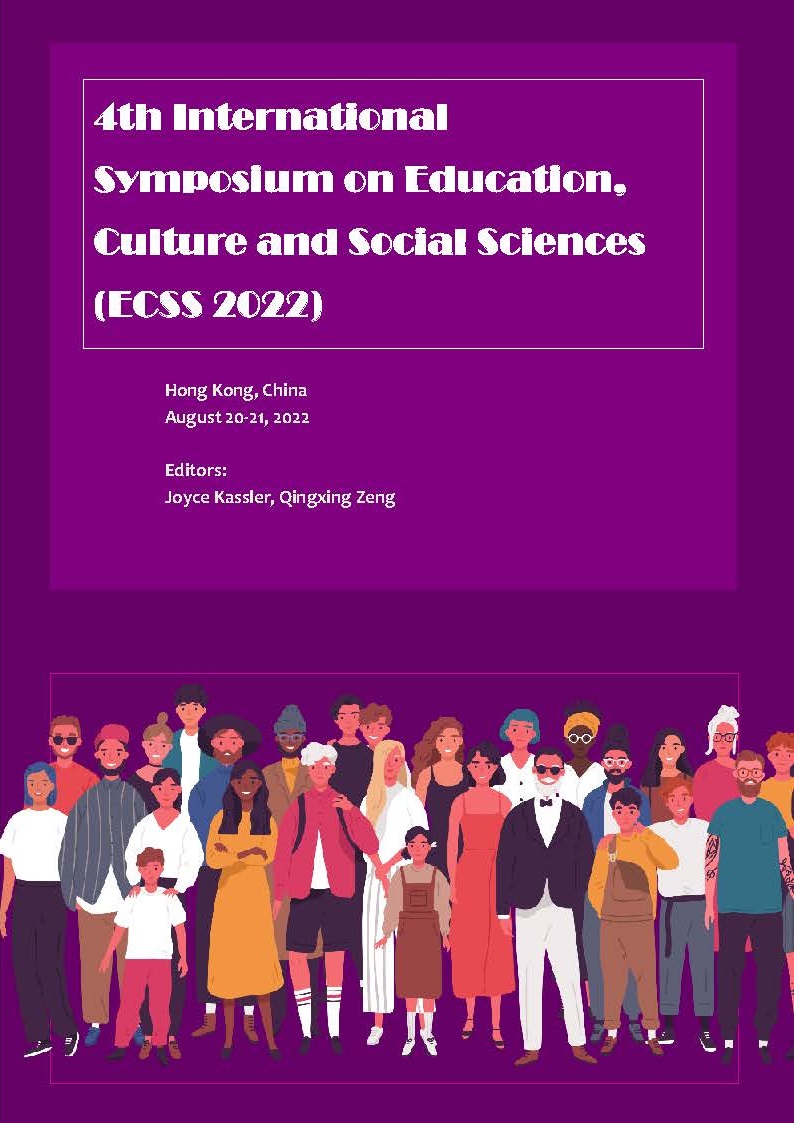A Review of Reasoning Variety Shows in China
DOI:
https://doi.org/10.54691/bcpssh.v19i.1545Keywords:
Reasoning variety show, Who’s the Murderer, literature reviewAbstract
In 2016, reasoning variety shows represented by “Who’s the Murderer” developed rapidly and received wide attention from academics. This paper combs through relevant literature and finds that research on reasoning variety shows focuses on program content construction, communication and marketing strategies, and impact and inspiration. However, the studies are mainly case studies, with limited perspectives, single case selection and insufficient depth of theoretical research.
Downloads
References
Sun X. Liu. The Development and Mode of Reasoning Reality Shows in China[J]. Media and Education,2018(Z1):170-173.
Liu Jianping. Research on Chinese Reasoning Variety Shows [D], Changsha: Hunan Normal University, 2017
Wu, Mingrui. A Study of Suspense Narratives in Reasoning Variety Shows[D]. Qufu Normal University, 2020.DOI: 10.27267/d.cnki.gqfsu.2020.000652.
Ma Sunan. Analysis of Audience Psychology and Communication Strategy of Case Deduction Shows[J]. Audiovisual,2021(01): 30-31.DOI: 10.19395/j.cnki.1674-246x.2021.01.012.
Tang Yi. Analysis of the Highlights and Prospects of the Varietyization of Reasoning Games on the Internet - Taking “Who’s the Murderer” and its Derivative Programs as an Example[J]. Western Radio and Television,2021,42(06):130-133.
The Paper “Reasoning Variety Show, Still Halfway Up the Mountain”, https: // www.thepaper.cn/newsDetail_forward_12933869
[French] Gérard Genet, translated by Wang Wenrong. Narrative Discourse New Narrative Discourse [M]. China Social Science Press, 1990.
Zvetan Todorov. The Analysis of Literary Works [A]. Zhang Yinde, ed. Studies in Narratology [C]. Beijing: China Social Science Press 1989 71.
Zhang Yinjiao. Analysis of the Narrative Mode of the Reality Reasoning Show “Cute Detective Solve Cases” [J]. Audiovisual,2021(09): 54-55.DOI: 10.19395/j.cnki.1674-246x.2021.09.022.
Li Dan. Reality TV Shows under Gennett’s Narrative Discourse Theory: The Case of “Who’s the Murderer” [J]. Media Forum,2019,2(03):113-114.
Wang Yue. The Immersive Experience under Three Layers of Narrative: An Analysis of the Narrative Strategy of “Great Escape” [J]. Sound Screen World,2019(12):25-26.
Liu Jianping. Analysis of the Narrative Discourse of Reasoning Variety Shows: The Case of “Who’s the Murderer” [J]. Western Radio and Television,2016(19):103-104.
Li Xianjie, Film Narratology: Theory and Examples [M], Beijing: China Film Press, 2000: 351-352
Li Dan. Research on the Narrative of the Reality Reasoning Game Variety Show “Who’s the Murderer” [D]. Hunan University of Technology,2019.
Liu Ruixing. A Brief Analysis of the Narrative Strategy of “Who’s the Murderer” [J]. The House of Drama,2018(29):87.
Shen Sijia. Analysis of the Use of “Real Scenes” in Reality TV Shows[J]. Audiovisual,2018(12):37-39. DOI: 10.3969/j.issn.1674-246X.2018.12.017.
Yang Yuchen, Xue Yuan. “Identity + Scene + Script”: Analysis of the Immersive Variety Narrative Strategy of “Cute Detective Solve Cases” [J]. New Media Research,2021,7(16): 116-119.DOI: 10.16604/j.cnki.issn2096-0360.2021.16.029.
Wang Huijing. “Who’s the Murderer” Season 2: Professional Process and Storytelling Editing [J]. Film and Television Production,2017,23(04):16-29.
Zhou Min, Chang Zixuan. The Development of Educational Online Variety Shows from “Who’s the Murderer” [J]. Southern Television Journal,2017(02):93-95.
Hu Man, Wan Jiaqi, Liu Keying, Zhang Yunqi, Chen Wei, Zheng Huanzhao. The Dilemma and Breakthrough of the N Generation of Variety Shows: The Case of “Who’s the Murderer” [J]. Yue Hai Feng,2020(05): 71-79.DOI: 10.16591/j.cnki.44-1332/i.2020.05.012.
Lv Lijun. The Construction of Fiction and Reality in Television Reality Shows: The Case of “Who’s the Murderer” [J]. Audiovisual,2021(7):44-45. DOI: 10.3969/j.issn.1674-246X.2021.07.018.
Lu Chunyu. The Use of Sound in Suspenseful Reasoning Variety Shows[J]. Southeast Communication, 2019(8): 140-142.
Zhang Nana. Research on the Integrated Marketing Communication of “Who’s the Murderer” [D]. Jiangxi: Jiangxi University of Finance and Economics, 2019.
Fang Ting, Lu Zhe. Analysis of the Innovation Path of Online Variety Shows - Taking “Who’s the Murderer” as an Example[J]. Contemporary Communication, 2020(1):69-72.
Dong Xianshang. On the Development of Reasoning Suspense Variety Shows[J]. Journalism Research Guide,2018,9(7):117-118. doi: 10.3969/j.issn.1674-8883.2018.07.076.
Li Zonglun. The Highlights of “Who’s the Murderer” [J]. Sound Screen World,2018(1):23-24. doi: 10.3969/j.issn.1006-3366.2018.01.010.
Zhong Taoyang. The Innovative Road of TV Variety Shows under Media Fusion-Take TV Variety Show “Who’s the Keyman” as an Example[J]. Journalism Research Guide,2019,10(7):186-187. doi: 10.3969/j.issn.1674-8883.2019.07.133.
Cao Qiumin. Research on the Reality Reasoning Show “Who’s the Murderer” from the Perspective of "5W" [D]. Heilongjiang: Harbin Normal University, 2020.
Niu Yue. An Analysis of the Communication Strategy and Advantages of Online Self-produced Variety Shows: The Case of “Who’s the Murderer” [J]. New Media Research,2018,4(5):129-131. DOI: 10.3969/j.issn.1671-7597.2018.05.052.
Wang Yuran, Liu Yingjie. Information Transmission and Feedback: Analysis of the Communication Model of “Who’s the Murderer” under 7W Communication Model[J]. Audiovisual,2022(4):86-89. DOI: 10.3969/j.issn.1674-246X.2022.04.026.
Wu Xi. Research on the Communication Strategy of Online Variety Show “Who’s the Murderer” [D]. Xinjiang University of Finance and Economics,2019.
Wang Ruiqi. Analysis of Audience Needs of Reasoning Variety Shows under Use and Satisfaction Theory[J]. Audiovisual,2021(1):28-30. DOI: 10.3969/j.issn.1674-246X.2021.01.011.
Luo Chengjie. The Success of Self-produced Variety Shows in the Perspective of “Use and Satisfaction”--The Case of “Who’s the Murderer”[J]. Journalism Research Guide, 2020, 11(9):12, 122. DOI: 10.3969/j.issn.1674-8883.2020.09.006.
Zhang Guyue. Analysis of the Success of “Who’s the Murderer” from “Use and Satisfaction” Theory[J]. Journalism Research Guide, 2017,8(9):81,84. DOI: 10.3969/j.issn.1674-8883.2017.09.050.
Qin Yang. Interpreting the Online Variety Show “Who’s the Murderer” from the Perspective of Bakhtin's "Carnivalization"[J]. Science and Technology Communication,2019,11(10):58-59. DOI: 10.3969/j.issn. 1674-6708.2019.10.032.
Zhai Zhan. The Benign "Carnival" of Online Variety Shows: Taking “Who’s the Murderer” as an Example[J]. Journal of Culture,2020(3):51-53.
Zhong Guoli. Research on the Marketing Strategy of Variety Programs in the New Media Era: Taking “Who’s the Murderer” as an Example[J]. Western Radio and Television,2020,3(6):87-89. DOI: 10.3969/j.issn.1006-5628.2020.06.042.
Yang Xinyi, Lu Xiaoyan. Research on the Localization IP Path of “Who’s the Murderer” [J]. Audiovisual, 2021(4):39-40. DOI: 10.3969/j.issn.1674-246X.2021.04.016.
Yang Fan. An Analysis of Brand Image Shaping of Reasoning Variety Shows in the New Media Environment - Taking “Who’s the Murderer” as an Example[J]. Media Forum,2019,2(13):88-89. DOI: 10.3969/j.issn.2096-5079.2019.13.060.
Su Xiao Cheng. Psychological Analysis of Audience Acceptance of Implanted Ads in the Online Variety Show “Who’s the Murderer” [J]. Audiovisual,2021(9):56-58. DOI: 10.3969/j.issn.1674-246X.2021. 09.023.
Bao Jifan, Tang Xi. An Analysis of the Implantation of Advertising in Online Variety Shows - Taking “Who’s the Murderer” as an Example[J]. Short story (original version),2018(35):62-63.
Qiao Xitong. Research Analysis on the Communication Effect of Implanted Advertising in Online Variety Shows - Taking “Who’s the Murderer” as an Example[J]. Sound Screen World,2021(2):89-90.
Lv Pin. Looking at the Marketing Strategy of Native Video Advertising from “Who’s the Murderer” [J]. News Forum,2019(5):111-114.
Zhang Shanrui. Exploring the Method and Development Trends of Implanted Advertising in Variety Shows - Taking “Who’s the Murderer” as an Example[J]. TV Guide,2017(9):149.
Wu Yudi. A study of Ethical Issues in the Expression of Social Issues in Immersive Online Variety Shows: Taking “Great Escape” as an Example[J]. Science and Technology Communication, 2021, 13(13): 173-175. DOI: 10.3969/j.issn.1674-6708.2021.13.061.
Shen F. Analysis of the Characteristics and Value Influence of Online Variety Shows - Taking “Who’s the Murderer” as an Example[J]. Western Radio and Television,2019(4):126,130. DOI: 10.3969/j.issn. 1006-5628.2019.04.070.
Liu Yao. Positive Energy Communication in Online Variety Shows: The Case of “Who’s the Murderer” [J]. Audiovisual,2019(9):22-23. DOI: 10.3969/j.issn.1674-246X.2019.09.010.
Zhang Hanwei. Characteristics and Reflections of Online Variety Shows: The Case of “Who’s the Murderer” [J]. Drama House,2020(14):98-99.
Ling Shaosong. The Value Guidance of Online Variety Shows - Taking “Who’s the Murderer” as an Example[J]. Sound Screen World,2021(23):56-57. DOI: 10.3969/j.issn.1006-3366.2021.23.025.
Liang Xinyi. Analysis of the Integration of Entertainment Deconstruction and Education in Online Variety Shows: The Case of “Who’s the Murderer” [J]. Communication Power Research,2020(1):48-49.
Zhang Jing. An Empirical Study on the Influence of Audience Experience on the Effect of Entertainment Education Persuasion in Online Variety Reality Shows: An Example of Online Variety Reality Show “Great Escape” [J]. Southeast Communication,2021(7):104-108.
















